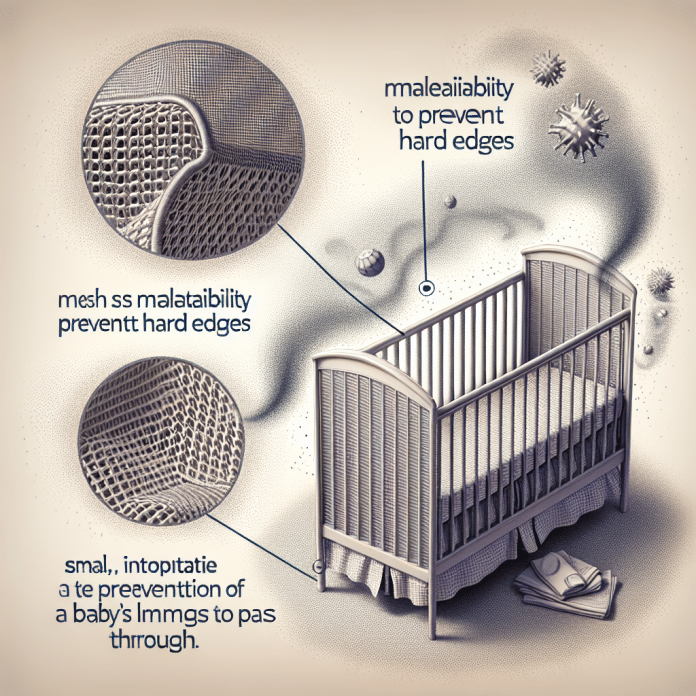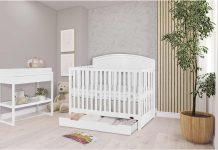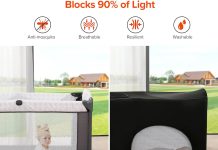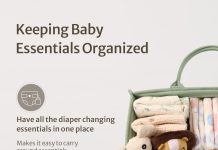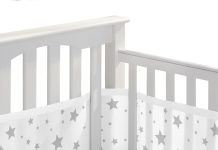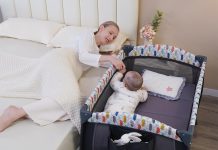Imagine this scenario: you are a new parent preparing for the arrival of your precious little one. As you set up the crib, you can’t help but worry about those hard edges that might pose a safety hazard to your baby. That’s where mesh crib liners come to the rescue. But how exactly do these seemingly simple accessories transform those sharp edges into a soft and cozy haven for your baby? In this article, we will explore the fascinating world of mesh crib liners and uncover the secret behind their ability to keep your baby both safe and snug.
Review contents
Benefits of Mesh Crib Liners
Promotes airflow in the crib
Mesh crib liners are designed with breathable mesh material, which allows for proper airflow in the crib. This helps to regulate the temperature and prevent the baby from overheating during sleep. The mesh construction allows air to circulate freely, ensuring a comfortable sleeping environment for your little one.
Easy to install and remove
One of the major benefits of mesh crib liners is their ease of installation and removal. They typically come with adjustable straps or ties that make it simple to secure them to the crib. This means that you can easily attach and detach the liners whenever necessary, whether it’s for cleaning or adjusting the crib layout. The convenience of these liners makes them a practical choice for busy parents.
Provides a soft cushioning
Mesh crib liners offer a soft cushioning around the crib edges, providing a cozy and comfortable environment for your baby. The padding helps to prevent any accidental bumps or bruises caused by hitting the hard edges of the crib. The gentle cushioning also adds an extra layer of comfort for your little one during sleep, allowing them to rest peacefully.
Reduces the risk of limbs getting stuck
One of the main concerns for parents is the risk of their baby’s limbs getting stuck between the crib slats. Mesh crib liners act as a protective barrier, reducing the chance of your baby’s arms or legs slipping through the gaps. The mesh fabric allows for easy visibility, ensuring that you can still keep an eye on your little one while they are safely surrounded by the liner.
Understanding the Construction of Mesh Crib Liners
Material composition
Mesh crib liners are typically made from a combination of breathable fabric such as polyester or cotton. The mesh construction ensures proper airflow, promoting a well-ventilated environment for your baby. It is important to choose a liner that is made from high-quality materials to ensure durability and safety.
Mesh design and patterns
Mesh crib liners are available in a variety of designs and patterns, allowing you to choose one that matches your nursery decor. The mesh design ensures visibility and breathability, while the patterns add a touch of style to the crib. Some liners feature cute and colorful prints, while others have a more minimalist and modern look. With the wide range of options available, you can find a mesh crib liner that suits your personal taste.
Impact of Mesh Crib Liners on Safety Standards
Meeting safety regulations
Mesh crib liners are designed to meet the safety standards set by regulatory agencies. They are required to undergo rigorous testing to ensure that they do not pose any risks to infants. When choosing a mesh crib liner, it is important to look for one that is certified and meets the safety regulations, giving you peace of mind that your baby is protected.
Preventing entanglement risks
One of the key safety concerns with crib bumpers is the risk of entanglement. Traditional crib bumpers with ties or strings can pose a hazard if they become loose or if the baby manages to pull on them. Mesh crib liners eliminate this risk by providing a secure barrier without any strings or ties that could potentially become a strangulation hazard.
Addressing concerns about breathability
Breathability is a crucial factor when it comes to crib safety. Mesh crib liners are specially designed to address concerns about breathability. The open-weave mesh fabric allows for adequate airflow, reducing the risk of suffocation or overheating. This makes them a safer alternative to traditional crib bumpers, which can restrict airflow and pose a suffocation hazard.
Proper Installation and Maintenance of Mesh Crib Liners
Ensuring a snug and secure fit
To ensure maximum safety, it is important to properly install mesh crib liners. Follow the manufacturer’s instructions carefully, making sure to secure the liners firmly to the crib. Ensure that there are no gaps or loose areas where your baby’s limbs could become trapped. Regularly check the fit of the liners to ensure they remain securely in place.
Regularly checking for wear and tear
Regular maintenance and inspection of mesh crib liners are important to ensure their safety and effectiveness. Check for any signs of wear and tear, such as frayed edges or holes in the mesh. If you notice any damage, it is recommended to replace the liner immediately to prevent any potential hazards.
Cleaning and washing instructions
Mesh crib liners are designed with convenience in mind, making them easy to clean and maintain. Most liners are machine washable, allowing you to easily remove any dirt or stains. Follow the manufacturer’s instructions for cleaning and washing to ensure the longevity of the liners. Regularly cleaning the mesh crib liners will help to maintain a hygienic sleep environment for your baby.
Alternative Options for Softening Hard Edges in Cribs
Traditional crib bumpers
Traditional crib bumpers are another option for softening hard edges in cribs. However, it is important to note that they have been associated with safety concerns due to the risk of suffocation and entanglement. It is recommended to choose mesh crib liners as a safer alternative.
Padded rail covers
Padded rail covers are specifically designed to soften the hard edges of crib rails. These covers are made from soft and padded materials, providing a cushioning effect that protects your baby from accidental bumps. Padded rail covers are easy to install and remove, making them a convenient option for parents.
Using blankets or quilts
An alternative option for softening hard edges is to use blankets or quilts. However, it is important to ensure that these are securely fastened to the crib and do not pose any suffocation or entanglement risks. It is recommended to consult with a medical professional or follow safe sleep guidelines when considering this option.
Advice from Pediatric Experts
Choosing the right crib liner
When selecting a crib liner, it is important to consider the advice from pediatric experts. Opt for mesh crib liners that are certified and meet safety standards. Look for liners that have a breathable mesh design and ensure a secure fit in the crib.
Considering the age of the child
Pediatric experts recommend considering the age of your child when using crib liners. While mesh crib liners are generally safe for infants, it is important to review and follow the manufacturer’s recommendations. Some experts may advise against using crib liners for older babies who are more mobile and could potentially use the liners as a step to climb out of the crib.
Monitoring the baby during sleep
Regardless of the type of crib liner used, it is essential to always monitor your baby during sleep. Regularly check on them to ensure they are comfortable and safe. Be vigilant for any signs of discomfort or potential hazards, such as loose strings or ties on the liner.
Common Misconceptions About Mesh Crib Liners
Not being a suffocation hazard
Contrary to some misconceptions, properly installed and well-maintained mesh crib liners are not a suffocation hazard. The breathable mesh fabric allows for adequate airflow, reducing the risk of suffocation or overheating. It is important to follow the manufacturer’s instructions, ensure a secure fit, and regularly inspect the liners for any damage or wear.
Compatibility with different crib styles
Mesh crib liners are designed to be compatible with most crib styles and sizes. They typically come with adjustable straps or ties that allow for a secure fit in various crib designs. However, it is recommended to check the specifications and compatibility of the liner with your specific crib model to ensure a proper fit.
Suitability for babies with allergies
Mesh crib liners made from hypoallergenic materials are available, making them suitable for babies with allergies. It is important to carefully read the product description and choose a liner that is specifically labeled as hypoallergenic. These liners are designed to minimize the risk of allergens and irritants, providing a safe and comfortable sleep environment for your baby.
User Experiences and Reviews
Parents’ feedback on comfort and safety
Many parents have shared their positive experiences with mesh crib liners in terms of comfort and safety. They often highlight the soft cushioning provided by the liner, which prevents their baby from hitting the hard edges of the crib. Parents also appreciate the breathable mesh design, which promotes airflow and ensures a comfortable sleeping environment. Overall, the feedback from parents is often positive, emphasizing the benefits and peace of mind provided by mesh crib liners.
Comparisons with other crib liner options
When comparing mesh crib liners with other crib liner options, such as traditional bumpers or padded rail covers, parents often consider safety as the primary factor. Mesh crib liners are favored for their breathability and reduced risk of suffocation and entanglement. Parents also appreciate the ease of installation and maintenance offered by mesh crib liners, making them a practical choice for busy parents.
Safety Considerations for Mesh Crib Liners
Avoiding loose strings or ties
To ensure the safety of mesh crib liners, it is crucial to avoid any loose strings or ties. Regularly inspect the liners to make sure that there are no loose or frayed parts that could pose a risk of strangulation. Keep the crib area free from any additional strings or objects that could accidentally become entangled with the liner.
Regularly inspecting for damage
Regular inspection of mesh crib liners is essential to identify any signs of damage. Check for holes, tears, or frayed edges in the mesh fabric. If you notice any damage, replace the liner immediately to maintain a safe sleeping environment for your baby.
Discontinuing use as the child grows
As your baby grows older and becomes more mobile, it may be necessary to discontinue the use of mesh crib liners. Older babies who are able to pull themselves up or stand in the crib may potentially use the liners as a step to climb out, increasing the risk of falls or injuries. Always review the recommendations of pediatric experts and manufacturers to ensure the continued safety of your child.
Mesh Crib Liners: A Safe Solution for Infant Sleep
Promoting a comfortable and safe sleep environment
Mesh crib liners offer a safe solution for parents looking to soften the hard edges of their baby’s crib. They promote adequate airflow, provide cushioning, and reduce the risk of limbs getting stuck in between the slats. By creating a cozy and comfortable sleep environment, mesh crib liners contribute to healthy and sound sleep for infants.
Addressing the need for crib edge softening
Softening the hard edges of cribs is vital to ensure the safety and comfort of babies. Mesh crib liners act as an effective barrier, protecting infants from bumps and bruises while maintaining breathability. By understanding their construction, installation, and maintenance, parents can confidently choose mesh crib liners as a safe solution for their baby’s crib.

